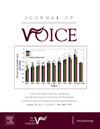将嗓音听觉知觉评估共识(CAPE-V)跨文化改编为马来语:有效性研究。
IF 2.5
4区 医学
Q1 AUDIOLOGY & SPEECH-LANGUAGE PATHOLOGY
引用次数: 0
摘要
嗓音的听觉-知觉评级是嗓音评估的一个组成部分,CAPE-V 是实现这一目的的工具之一。由于其优势,CAPE-V 已被改编成多种语言。因此,将 CAPE-V 改编成马来语对其在马来西亚人口中的实用性至关重要,这也是本研究的目标。本研究包括将 CAPE-V 翻译成马来语,称为马来语 CAPE-V,然后确定其有效性。翻译过程(即正译和反译)涉及四位不同的翻译人员,即三位语言治疗师(SLT)和一位至少有 14 年经验的语言学家。除了少数几个项目的译文相似外,大多数项目的译文都是相似的。在内容效度检查中,两名至少有 12 年临床经验的评分员(即 SLT)对测试项目进行了审阅和评分。鉴于量表级内容效度指数平均值(S-CVI/Ave)高于可接受水平,所有项目均被保留。对结构效度和并发效度的检验涉及对 38 名参与者(包括 19 名正常嗓音和失调嗓音者)录制的嗓音样本进行评分。评定由三位具有至少 12 年临床经验的评定者(即 SLT)进行。在结构效度方面,曼-惠特尼 U 检验表明,嗓音失调组的马来 CAPE-V 声乐参数得分明显高于正常嗓音组。同时效度方面,斯皮尔曼相关性表明,马来语 CAPE-V 声乐参数得分与 GRBAS 量表之间的所有关系都是显著的,其中大部分都达到了非常强的正相关。结果表明,马来语 CAPE-V 是对马来西亚人的嗓音进行听觉-知觉评级的有效工具。本文章由计算机程序翻译,如有差异,请以英文原文为准。
Cross-cultural Adaptation of the Consensus Auditory-perceptual Evaluation of Voice (CAPE-V) Into Malay: A Validity Study
Auditory-perceptual rating of voice is one component of voice evaluation, and the CAPE-V is one of the tools for this purpose. Because of its advantages, the CAPE-V has been adapted into several languages. Accordingly, the adaptation of the CAPE-V into Malay is essential for its utility among the Malaysian population, which this study aimed to accomplish. This study involved translating the CAPE-V into Malay, termed the Malay CAPE-V, followed by establishing its validity. The translation processes (ie, forward translation and backward translation) involved four different translators ie, three speech-language therapists (SLTs), and one linguist with at least 14 years of experience. Most items were similarly translated, except for a few, which were subsequently accepted as similar, following consensus among the translators. In the examination of content validity, two raters (ie, SLTs) with at least 12 years of clinical experience reviewed and scored the tested items. Given that the scale-level content validity index average value (S-CVI/Ave) was above the acceptable level, all items were retained. The examination of construct validity and concurrent validity involved ratings of voice samples recorded from 38 participants, comprising 19 individuals with normal and disordered voices, respectively. The ratings were performed by three raters (ie, SLTs) with at least 12 years of clinical experience. For the construct validity, the Mann-Whitney U test indicated significantly higher scores of the vocal parameters of the Malay CAPE-V for the disordered voice group than for the normal voice group. Meanwhile, for the concurrent validity, the Spearman correlation indicated that all relationships between the scores of the vocal parameters of the Malay CAPE-V and GRBAS Scale were significant, with most of them achieving a very strong positive correlation. The results demonstrated that the Malay CAPE-V is a valid tool for an auditory-perceptual rating of voice among the Malaysian population.
求助全文
通过发布文献求助,成功后即可免费获取论文全文。
去求助
来源期刊

Journal of Voice
医学-耳鼻喉科学
CiteScore
4.00
自引率
13.60%
发文量
395
审稿时长
59 days
期刊介绍:
The Journal of Voice is widely regarded as the world''s premiere journal for voice medicine and research. This peer-reviewed publication is listed in Index Medicus and is indexed by the Institute for Scientific Information. The journal contains articles written by experts throughout the world on all topics in voice sciences, voice medicine and surgery, and speech-language pathologists'' management of voice-related problems. The journal includes clinical articles, clinical research, and laboratory research. Members of the Foundation receive the journal as a benefit of membership.
 求助内容:
求助内容: 应助结果提醒方式:
应助结果提醒方式:


